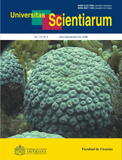Abstract
El crecimiento acelerado de la población a nivel mundial ha generado un aumento en la demanda del recurso hídrico y en los niveles de contaminación del mismo. Los residuos tanto de origen doméstico como industrial generan problemas a nivel ambiental y de salud pública. En el caso específico de la contaminación de origen doméstico, el mayor riesgo se presenta por las altas concentraciones de materia orgánica y microorganismos patógenos que pueden difundirse a través del agua. Determinar la presencia de los patógenos en el agua requiere de laboratorios especializados y técnicas costosas que tardan varios días. Como alternativa, se propone el uso de indicadores de contaminación fecal (bacterias, virus y parásitos), los cuales requieren técnicas más sencillas, rápidas y económicas. Con el objeto de conocer la presencia, concentración y comportamiento de indicadores bacterianos (coliformes fecales), virales (fagos somáticos y F específicos) y parasitarios (huevos de helminto, Giardia spp., y Cryptosporidium spp.) en nuestras condiciones ambientales, se realizaron varios muestreos en aguas superficiales, subterráneas, sistemas de potabilización y depuración en la Sabana de Bogotá (Colombia). Los resultados mostraron la presencia de los indicadores propuestos en todas las muestras de agua y concentraciones similares a las encontradas en otros países con condiciones ambientales diferentes.
Palabras clave: agua, calidad, contaminación, indicadores, riesgo sanitario.
Abstract
The world’s population is growing at such rate that not only the demands for water supply have raised considerably but also its contamination levels. Residues from domestic and industrial origin have generated environmental problems and public health issues. Water contamination coming from domestic origin, shows a higher risk because of the quantity of organic matter and the presence of pathogenic microorganisms. Due to determinations of these pathogens requires sophisticated laboratories and the techniques used for their detection are very costly and time consuming, it is proposed an alternative technique using bacteria, virus and parasites as faecal indicators, since they exhibit similar behaviour, and their determination techniques are a lot simpler, faster and low cost. The objective of the present study is to evaluate the occurrence, concentration and behaviour of indicators from bacterial origin as faecal coliforms, from viral origin as somatic coliphages and F-specific RNA bacteriophages, and from parasite origin such as helminth eggs, Giardia cysts and Cryptosporidium oocysts. A series of samples were taken at surface, groundwater, drinking water and wastewater treatment system in the surrounding area of Bogotá (Colombia). The results show the presence of all microbial indicators in all water samples, in similar concentrations to those found in different countries with different environments.
Key word: contamination, indicators, quality, sanitary risk, water.
Univ. Sci. is registered under a Creative Commons Attribution 4.0 International Public License. Thus, this work may be reproduced, distributed, and publicly shared in digital format, as long as the names of the authors and Pontificia Universidad Javeriana are acknowledged. Others are allowed to quote, adapt, transform, auto-archive, republish, and create based on this material, for any purpose (even commercial ones), provided the authorship is duly acknowledged, a link to the original work is provided, and it is specified if changes have been made. Pontificia Universidad Javeriana does not hold the rights of published works and the authors are solely responsible for the contents of their works; they keep the moral, intellectual, privacy, and publicity rights. Approving the intervention of the work (review, copy-editing, translation, layout) and the following outreach, are granted through an use license and not through an assignment of rights. This means the journal and Pontificia Universidad Javeriana cannot be held responsible for any ethical malpractice by the authors. As a consequence of the protection granted by the use license, the journal is not required to publish recantations or modify information already published, unless the errata stems from the editorial management process. Publishing contents in this journal does not generate royalties for contributors.



